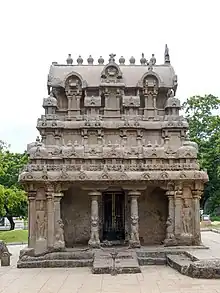
.jpg.webp)


A mandir kalash is a metal or stone spire used to top the domes of Hindu temples. Kalashas as architectural feature has been used at least before the first millennium BCE and were made of terracotta and wood during this early period. They were used as decorative element placed on top of various types of buildings.[1] They are mainly restricted to temple architecture today.
Present in the form of an inverted pot with a point facing the sky, kalashams are prominent elements of temple architecture. According to the Aitareya Brahmana, a golden kalasham is regarded to represent a sun upon the summit of a deity's dwelling, the temple.[2]
Most kalashams are made of metal and some of stone. The view of the gopuram (temple tower) is one of the important rituals of Hindu worship along with view of dvajastambham (temple flag mast). These gopurams are usually topped with ornamental kalashams. Kalashams are consecrated during the kumbhabhishekam ceremony and are venerated during pujas.[3]
Types
Basically, There are four types of mandir kalash:
- Singh-Kalash (Singh: Horn): this is the most commonly used kalash, such as in the Siddhivinayak Temple in Mumbai. It is shaped like the horn of a bull. Hence, it is named so.
- Tri-Kalash (Tri: Three): This is a group of three long kalash. It is mostly used on Gopurams and main gates. Example: Badrinath Temple.
- Matka-Kalash (Matka: Pot): This kalash is shaped like pitchers and earthenware pots. it appears as if pots have been placed on top of one another. Example: Mumba devi Temple.
- Gol-Kalash (Gol: Round): This kalash is round and has a very small and fine tip on top. Example: Jagannath Temple, Puri
Materials
Kalash are mostly made of metal. Main metals used are steel, iron, aluminium and bronze. In famous temples like Shree Samadhi Mandir, Shirdi and Tirupati, noble metals like gold and silver are used. Platinum is rarely used.
In ancient times, temples carved out of stone had stone kalash. Many temples like Ellora Caves, Hampi and Mahabalipuram still have these stone kalash. In South India, Kalash made of wood are common. Also, in small wooden temples used in homes by Hindu people, kalash are carved of wood or made of metal.
Gallery
 Ganesha temple at Mahabalipuram, 600s CE.
Ganesha temple at Mahabalipuram, 600s CE. Tri Kalash on a Gopuram in Meenakshi Temple, Madurai
Tri Kalash on a Gopuram in Meenakshi Temple, Madurai A Metal Matka Kalash
A Metal Matka Kalash Stone carved kalash, Kailasha Temple, Ellora Caves
Stone carved kalash, Kailasha Temple, Ellora Caves Tri Kalash, Badrinath Temple
Tri Kalash, Badrinath Temple Singh Kalash, Chennakeshava Temple, Belur
Singh Kalash, Chennakeshava Temple, Belur Matka Kalash, Shree Samadhi Mandir, Shirdi
Matka Kalash, Shree Samadhi Mandir, Shirdi Gol Kalash, Jagannath Temple, Puri
Gol Kalash, Jagannath Temple, Puri Wide and Flat Singh Kalash, Abu Ambaji Temple, Gujarat
Wide and Flat Singh Kalash, Abu Ambaji Temple, Gujarat
References
- 1 2 Uesugi, Akinori; Oya, Hiroshi; Peter, Jenee (2020). "Roof Tiles in Ancient South Asia: Its Developments and Significance". Center for Cultural Resource Studies, Kanazawa University, Kakuma-machi, Kanazawa, Ishikawa.
- ↑ Kramrisch, Stella (1976). The Hindu Temple. Motilal Banarsidass Publ. p. 355. ISBN 978-81-208-0224-7.
- ↑ Keul, István (2017-02-06). Consecration Rituals in South Asia. BRILL. p. 324. ISBN 978-90-04-33718-3.